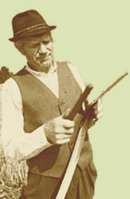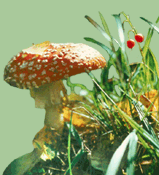Landscape home to people, habitat for nature
Hannes Palang makes an introduction to the European Day of Parks, wih the official heading of Our Landscapes space for nature, opportunities for people. He writes about the changed relationship between people and nature, about urbanization in rural areas, valuable landscapes, European Landscape Convention, researchers of local lore and about bordering our properties. Nature is not perceived naturally any more, therefore nature has to be protected against the people.
Estonian Nature enquires
Gea Järvela writes about the activities of the Vellavere nature house.
Erik Sikk gives a short overview of the activities of the 2-year old Renewal Center of Tallinn.
The formation of a fossil
Oive Tinn and Tõnu Meidla describe a seemingly misunderstandable phenomenon: in spite of decaying, the remnants of dead organisms are preserved as fossils for billions of years. The article explains the process of fossilization. The first precondition for fossilization is the layer of sediments that buries the organism. Therefore, the organisms living in wet environments are more liable to sedimentation. In the following historical periods a number of geological processes transform the organism into a fossil. Fossilization encmpasses animals, but also plants, bacteria and even traces of activity, like caves and cavities.
Tree of the year: Willows as simple as that!
Tõnu Ploompuu finds it really easy to determine willows at the time of their blooming period. The author lists the characteristic features of willow groups, and the colourful close-up photographs help to recognize the different species in nature.
Lichens are now officially protected
Tiina Randlane introduces 51 rare lichen species, which are now, for the first time, included in the list of Estonian protected natural objects. Therefore, 5% of the species are now protected. The present article classifies and presents the protected lichens according to the protection category.
Ornithological Society: a fresh oldster
Toomas Jüriado recalls the famous past and the active present of one of the oldest nature protection societies in Estonia. The main activities of today involve the formation of bird areas (hoiuala), participation in LIFE-projects and the compilation of the new atlas of hatchers.
Ubari Landscape Protection Area
Reigo Roasto calls to see a section of North-Estonian klint cliff near Kaberneeme. The protected area encompasses several key habitats related to klint, and is home to several protected plant species.
Interview: Nematods, garden and shorthand
Toomas Kukk has interviewed Eino Krall, the researcher of nematods.
Lekking
Jaanus Järva tries to guess the reasons why the spring gathering of blackcocks is also referred to as arena behaviour. He detailly describes this ancient-looking tradition, with all elements of showtime: the arena, contestants, rules, time and result. The dramatic show takes place at sunrise.
The third year of bird atlas has begun
Jaanus Elts and Andrus Kuus invite all hobby-ornithologists to contribute for the new atlas of breeding birds of Estonia. The included table gives an overview of the present status of the work. The observation squares that still need to be filled are also pictured on the added map.
Primrose, pretty and edible
Urmas Kokassaar praises the vitamin-rich spring flower, but warns against overdose. Although remarkably rich in vitamin C, the leaves contain soap-like ingredients that can easily irritate the mucous membrane. Therefore, the young leaves, as well as tea should only be consumed in small amounts. The pretty blossoms are used as garnish, but also for making wine and liquers.
Hiking trail: the Pähni forest trail is quite a challenge
Katre Palo gives guidance to those who want to hike on the forested nature protection area of South-Estonia. The 3 km-long hiking and learning trail has 28 points of interest. The information boards are full of interesting knowledge, diversified with different puzzles and tasks. In addition to nature, one can also learn about history and historical traditions related to forestry.
The dignified Estonian Jakob Johnson 200
Aimur Joandi writes a memorial about Jakob Johnson, who grew from the son of a serf to a world-famous agricultural scientist. His scientific activity was very fertile, ranging from crop rotation to ways of improving the distillation of spirits, from giant carrots and corn to the use of electricity in agriculture.
Essay: What is good and what is bad? By Rein Kalamees
The dangerous life of penduline tit
Sven Zaèek takes a glance into the spring days of a pair of penduline tits: how they weave their basket-like nest around branches and whether it provides a safe home for the little bird. The author observed the process of profound nest-making during two days and got some wonderful photographs of this modest and rare bird.
|


![[IN ENGLISH]](images/gb.gif)





